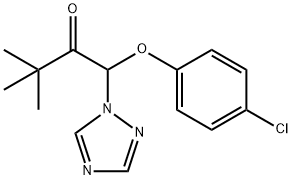TriadimefonSolutioninHexane , 1000 μg/mlinhexane, uncertainty 2% , 43121-43-3
Synonym(s):
1-(4-Chlorophenoxy)-3,3-dimethyl-1-(1H-1,2,4-triazol-1-yl)-2-butanone
CAS NO.:43121-43-3
Empirical Formula: C14H16ClN3O2
Molecular Weight: 293.75
MDL number: MFCD00055506
EINECS: 256-103-8
| Pack Size | Price | Stock | Quantity |
| 1.2ml | RMB239.20 | In Stock |
|
| others | Enquire |
PRODUCT Properties
| Melting point: | 82°C |
| Boiling point: | 441.9±55.0 °C(Predicted) |
| Density | 1.2200 |
| vapor pressure | 2 x l0-5 Pa (20 °C) |
| refractive index | 1.5388 (estimate) |
| Flash point: | 11 °C |
| storage temp. | APPROX 4°C |
| solubility | DMF: 30 mg/ml; DMSO: 30 mg/ml; DMSO:PBS(pH7.2) (1:1): 0.5 mg/ml; Ethanol: 10 mg/ml |
| form | Solid |
| pka | 1.41±0.11(Predicted) |
| color | White to off-white |
| Water Solubility | 0.026 g/100 mL |
| Merck | 13,9666 |
| BRN | 619231 |
| NIST Chemistry Reference | 2-Butanone, 1-(4-chlorophenoxy)-3,3-dimethyl-1-(1h-1,2,4-triazol-1-yl)-(43121-43-3) |
| EPA Substance Registry System | Triadimefon (43121-43-3) |
Description and Uses
Triadimefon has been a widely used fungicide on crops and nonfood products since the early 1970s. The metabolite triadimenol is also active and is registered separately for use as seed treatment. Triadimenol has a broad regulatory toxicology database, but its toxicity is considered to be encompassed in that of triadimefon and therefore the same study was used by the United States Environmental Protection Agency (US EPA) in establishing regulatory levels for both pesticides. In nontarget species, dopaminergic neurotoxicity is the primary effect, but with chronic exposures its toxicities include hepatic, carcinogenic, developmental, and reproductive effects.
Triadimefon is used for the control of powdery mildews in cereals, pome fruit, stone fruit, berry fruit, vines, hops, cucurbits, tomatoes, vegetables, sugar beet, mangoes, ornamentals, turf, flowers, shrubs and trees, Monilinia spp. in stone fruit, black rot of grapes, leaf blotch, leaf spot and snow mould in cereals, pineapple disease butt rot in pineapples and sugar cane, leaf spots and flower blight in flowers, shrubs and trees and many other diseases of turf.
Safety
| Symbol(GHS) |   GHS06,GHS09 |
| Signal word | Danger |
| Hazard statements | H302-H317-H330-H410 |
| Precautionary statements | P260-P273-P280-P301+P312-P302+P352-P304+P340+P310 |
| Hazard Codes | Xn,N,T,F |
| Risk Statements | 22-43-51/53-39/23/24/25-23/24/25-11 |
| Safety Statements | 24-37-61-45-36/37 |
| RIDADR | 2588 |
| WGK Germany | 2 |
| RTECS | EL7100000 |
| HazardClass | 6.1(b) |
| PackingGroup | III |
| HS Code | 29339900 |
| Hazardous Substances Data | 43121-43-3(Hazardous Substances Data) |
| Toxicity | LD50 in male, female rats (mg/kg): 568, 363 orally (Michel, Pourcharesse) |





